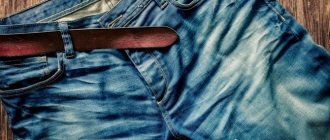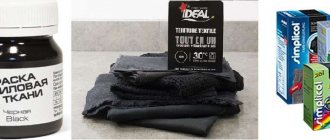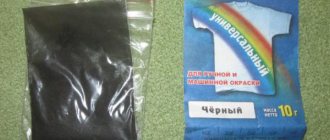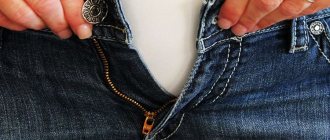How to dye jeans blue
Most often, jeans take on the appearance of an old, worn item when, after numerous washes or due to fading in the sun, they lose color.
How to restore color to jeans? First, let's look at a quick option for giving things a blue or blue tone using blue.
To tidy up and update blue or blue jeans, they have been using bluing since Soviet times. What is this paint? Blue is a solution of an organic dye - methylene blue. Pigment is used to give a bluish tint to natural fabrics.
How to dye jeans at home:
How to dye jeans blue? Follow the instructions:
- Pour the contents of the blue package into an enamel or plastic bowl. Add slightly warm water (not higher than 30 °C). Adjust the amount of water based on what color you need.
- To make the shade more durable, add 3-4 tbsp to the solution. l. salt. Stir.
- Place the denim item in the blue liquid.
- Leave for 3-4 hours. Remember to turn the jeans over periodically to ensure an even color.
- Rinse the item in a weak vinegar solution (50 ml of vinegar per 5 liters of water).
Potassium permanganate, or potassium permanganate, can give jeans a bluish or purple tint. To tint something, follow the same steps as when painting it blue.
Be prepared for the fact that the color after bluing or potassium permanganate will be washed out with each subsequent wash.
Recommendations
For the first couple of washes, do not combine jeans with other things, but put the same old towel with them. The fact is that the paint may still be washed out of the pants for some time. To prevent it from fading, use cool or lukewarm water and a gentle detergent.
When painting, wear gloves and use protective equipment - a robe or shirt, a mask if the paint has a strong smell. Free your workplace from textiles - carpets, towels, curtains. Once you splash things, you won’t be able to wash them off.
Be careful when wearing pants - they can stain leather and light-colored objects, such as white upholstered chairs or leather chairs.
Even if you go through several dye cycles, your jeans will not be as deep black as a store-bought item. Don't have high hopes for home dyeing.
How to dye jeans black
Before you dye your jeans black, you need jeans dye. The dye "Tekhnokhim" has proven itself well, the composition is Jeans, it is sold in hypermarkets or in handicraft stores.
Jeans dye is a blue-gray powder. Before dyeing black or blue jeans, put on rubber gloves, pour dye powder, 200 grams of salt, and jeans soaked in water into the drum of the washing machine.
Select the cotton program 60 or 95 degrees. The longer the washing time, the more saturated the color will be. We are waiting for the process to finish. Next, after finishing the washing cycle, you need to fix the black color. To fix the color, pour 5 tablespoons of vinegar into the dish of the washing machine and turn on the “rinse” mode. Do not turn on the spin mode! Otherwise, the dyed jeans will end up with streaks.
How and with what to dye black jeans
When dyeing black fabric, you have to restore the original shade, so only black dye is needed.
Powder dyes for jeans
A universal powder dye for fabric is perfect for jeans.
It is used economically, acts effectively, and does not spoil the structure of the fabric. Using it according to the instructions, achieving the desired result will not be difficult.
Fabric paint
Hardware stores sell fabric dyes. They have a powder structure and are used for painting in the washing machine.
- The powder is mixed with water in the proportion prescribed by the manufacturer.
- The jeans are turning inside out.
- The machine sets the temperature allowed for jeans.
- If the instructions for the paint do not indicate that it requires dilution, then it is poured into the drum onto the jeans that were previously placed there.
- Fabric softener is not added as it may alter the dyeing result.
- The machine is set to a mode for jeans; if it is not there, then a mode is selected, for example, for cotton or linen, at which the water temperature will be 80-90 °C.
- After washing is completed, the jeans are rinsed in cool water with a vinegar solution added to fix the color.
- After rinsing, the jeans are washed again on a short cycle with powder.
- Dry away from heating objects.
Hair dye
It is better to choose a natural dye without ammonia. On average, one pair of jeans takes two packs. The paint is diluted using the usual method according to the manufacturer's recommendations. Clothes are placed in a deep basin and completely filled with warm water in which the prepared paint is diluted. Jeans remain in the dyed mixture for 1.5-2 hours.
After soaking, rinse first in water at room temperature, and then in cold water with vinegar and salt. Then they are washed by machine with the addition of powder and dried in natural conditions.
Aerosol and acrylic paints
They help not to re-dye jeans, but to decorate them. Aerosol paints are simply sprayed onto laid out clothes, and an arbitrary image is drawn with acrylics. Paint with a brush or the edge of a washcloth. The image is unique, but uneven. Additionally, you can use a stencil. To fix the acrylic, the jeans are placed between layers of white paper and ironed.
Ink from felt-tip pens
The rods are removed from several black felt-tip pens and lowered into slightly cold water. When the water turns black, the jeans are immersed in it. After an hour, it is removed from the ink solution, washed with powder and dried.
Application of whiteness
For a long time in the post-Soviet space, denim jeans have remained trendy. Every self-respecting fashionista knew by heart the secrets of creating a fashionable new thing from ordinary trousers. This is a simple matter, since the usual “Whiteness” will help you.
- Dilute a glass of “Whiteness” in a bucket of water.
- Twist the item well into a sausage and secure it in several places with rubber bands.
- Immerse them in a container with the solution and begin to gradually heat the basin on the stove. In this situation, you will need at least 15 minutes for the procedure. Be careful not to let the jeans float to the surface.
In this way, you can dye black or blue jeans so that large unusual patterns are formed on the surface.
Painting stages
When everything is ready, we move on to painting the products. Following the instructions, pour the dye into a small bowl. Add water gradually, stirring the paint thoroughly until it is completely dissolved. Now strain the dye solution and pour it into the container in which the product will be dyed. Dilute the paint with water until it completely covers the item.
Place the container on the stove. Now you can immerse the product in the dye. To obtain a uniform color, rotate the fabric in a circle using a spatula or sticks. You need to remove the product when it becomes darker in color than you want. The fabric will lighten as it dries. To get streaks, the product must be twisted, as if wrung out, and secured with rubber rings.
Rinse the painted material well in water. After the last rinse, the water should remain clean. The better you rinse the fabric, the less it will shed during subsequent washes. Do not dry painted items in the sun or near a stove.
How to dye things with natural dyes
Miss Clean magazine recommends adhering to the following rules when dyeing using natural products:
- Test the natural product on a small piece of fabric before painting.
- Fill the selected raw material with water in a ratio of 1:2. Place on the stove, bring to a boil, then immediately remove. Now let the future dye brew. The longer the raw material is infused, the richer the color will be.
- It is necessary to prepare the tissues by immersing them in a fixing solution. For berries: 0.5 cups of salt per 2 liters of water; for vegetables: vinegar + water in a ratio of 1:4.
- Now things can be immersed in dye. Keep them until you get the desired shade. Remember that the fabric will become slightly lighter as it dries.
- Dry fabrics on a hanger, this will help avoid streaks.
Features of denim dyeing
The most common jeans in stores are all shades of blue, light blue and gray. Grays and blacks fade the most over time. Dark blue colors are long lasting.
It should be borne in mind that even after several dyeing procedures, denim is unlikely to become perfectly black, as in the store. Even with professional products you will get a dark gray color.
Preparing tissue for the procedure
To ensure that the paint goes on as evenly as possible, you need to prepare the denim for dyeing:
- Wash the product thoroughly. Set the water temperature to 40°C - this is the optimal value for denim. Wash as usual - with powder and conditioner. After washing, do not dry the jeans - dyeing is done on damp fabric. For light blue and light blue jeans, this step is sufficient. Further actions are carried out on products of bright or dark colors: red, burgundy, purple, dark blue and the like.
Washing is necessary to remove substances from the fabric that may interfere with the coloring or make it uneven. - Fill a large saucepan with water. The size of the pan should be large enough to wash jeans in it. Add bleach to water. Ordinary chlorine may also work, but it is better to use more gentle products, for example, Belize. It is added to water in a ratio of 1:10. Washing should be done in a well-ventilated area, as chlorine vapors are hazardous to health.
White is a good way to bleach jeans. - Place a saucepan of water over high heat.
The size of the pan should allow the product to be completely soaked in it. - When the water is ready to boil, reduce the heat to low and place the jeans in the pan. While stirring the product with a long wooden spoon or spatula, soak it in hot water until it lightens by 2-3 shades. Some jeans may change color to beige or yellowish - this is normal. Discoloration will take 30 to 60 minutes.
A wooden spoon with a long handle is convenient for stirring jeans in a large saucepan - the wood does not heat up from the steam - Turn off the heat and drain the bleach solution from the pan. Rinse your jeans thoroughly.
To remove bleach from jeans, rinse them in running water. - Wash the jeans again in the washing machine using detergent. This will remove any remaining bleach that could interfere with the paint job or damage the fabric. Do not dry the product before painting.
Natural dyes
What else can you tint your jeans with? To give a green tint, a solution of pharmaceutical green is suitable. Light-colored products are easily colored with herbal infusions, berry and fruit juices. Berries give the most durable coloring. Remember how difficult it can be to remove a random drop of juice from clothes. The downside of this method is that you will need a lot of berries to squeeze the juice.
Blackberries, blueberries, and cauliflower give fabrics a blue tint. Brown color - tea leaves, oak bark. Yellow - turmeric, dried calendula flowers. Pink - cherry or raspberry juice.
General rules for coloring with infusions and juices:
- A decoction or infusion is prepared from herbs, and juice is squeezed from berries.
- The intensity of the color depends on the amount of water added.
- The fabric is soaked for at least 4-5 hours.
- To ensure uniform coloring, you need to stir the product.
- Rinse in a weak vinegar solution.
Where can you dye clothes?
You can restore faded or faded dye on textiles at home or at a dry cleaner. Coloring things will help restore the previous shade or create a new one. If your white jeans have faded to a yellowish or gray color, they can be dyed or bleached.
You can dye textiles at home by hand or in a washing machine. Both of these methods are effective and extremely simple. Using the recommendations, you will cope with the task without much effort.
Manual painting method
To work with textiles you will need:
- Dye;
- Household scales;
- Salt;
- Vinegar in an amount of 30 ml;
- Large metal container.
- The dyeing method depends on the dye that will be used. Using a scale, you need to determine the weight of the clothing in order to accurately calculate the proportion of the dye. The intensity of coloring and color fastness will depend on this.
- Vinegar and salt are used to fix the paint. These substances are dissolved in water and textiles are rinsed in them. The last rinse is carried out in cool water without additives.
Changing the color of clothes in the washing machine
- Many people are familiar with the situation when one colored sock can turn a dozen white things into a different color. An absurd problem was inspired by the method of household dyeing of clothes.
- The whole process can be divided into several stages:
- Prepare the product for painting. This could be pants or a jacket. It is important to pre-wash, remove stains if possible and remove decorative elements.
- Measure the weight of the clothes.
- Prepare the dye according to the instructions.
- Strain the prepared solution through cheesecloth or a fine sieve and pour into the drum or compartment for washing powder.
- Place clothes in the washing machine compartment. It is better to load items immediately after pre-washing. Damp fabric is easier to dye.
- Set the boiling program to 95 degrees.
- Set the timer for at least 30 minutes.
- At the end of the wash cycle, add salt to the drum and rinse. The amount of salt should correspond to the proportion: 1 cup per 1 kg of fabric.
- You can repeat the vinegar rinse and do a short wash without additives to lock in the dye and wash out any remaining dye that didn't take.
- Remaining pigment can be removed from the drum by dry washing with liquid bleach. The rubber seal should be wiped with a clean cloth.
Preparing for painting
Before you start work, you need to prepare everything you need, namely:
- things intended for dyeing;
- container and devices for turning fabric;
- dyes and rinses.
Selecting containers and equipment for coloring
Once the clothes are prepared for dyeing, you can begin choosing a container.
Any clean utensil will do, be it an enamel basin or an aluminum pan.
The main thing is that there are no traces of scale or soot on the inner surface of the metal. Particular attention should be paid to the size of the container. The pan should be of such a volume that the thing to be painted is located freely in the solution, does not squash and does not rise above the surface of the water.
To stir and turn the product while working, you will need wooden tongs. If you don’t have such a device on your farm, you can use ordinary wooden sticks, after first clearing the surface of knots and uneven surfaces.
It is better to take soft water for the procedure, for example, rain or melt water. If this is not possible, then ordinary tap water can be softened with baking soda, for which 1 tbsp. l. powder is dissolved in 10 liters of water.
Blue for jeans
The simple and affordable composition is ideal for restoring the color of classic denim items. The drug is available for purchase in hardware stores. Please read the instructions carefully before use.
Please note that the substance is suitable for tinting blue items. It will not be possible to completely change the shade with this help. The durability of the bluing is not high, so after a while you will have to repeat the procedure.
Another point that cannot be neglected is that during the washing process after dyeing, the pigments from the fabric will be washed out, so it is better to wash the item separately from others or with clothes of the same color.
Extreme and experimental dyes for denim
Experimenters who are not tempted by proven and modern dyeing methods can turn to folk ingenuity. It is unlikely that high-quality uniform coloring can be achieved with the following options, but if someone is not afraid of unexpected results, why not try? After all, if methods exist, then someone needs it.
- Marker ink. To get paint, you need to dip the rods of a dozen or two felt-tip pens into water and leave until they turn completely white. Dip jeans into the resulting liquid and leave for a couple of hours. It is worth considering that the fabric should be much lighter than the felt-tip pens used.
- Natural dyes are also great for denim. Every food product contains pigment in greater or lesser quantities. If you choose bright vegetables, fruits, berries, herbs, seasonings, you can get an interesting result. Grind the selected ingredient and add water 1:2. Boil and let it brew for longer, the richer the desired color. Strain. Dilute 4 parts vinegar with 1 part dye, add ½ part salt. Boil the jeans in the resulting solution for an hour.
- Hair dye. For one pair of pants, take 2 packs of ammonia-free paint, dilute with water (it should be enough to completely cover the jeans, but no more). Soak the jeans for a couple of hours.
- Henna and coffee will give your jeans a brown color. Mix a pack of henna with 2 tbsp. ground coffee. Use in the same way as natural paints.
Waxing
After waxing, the denim material becomes impervious to external factors, and the paint applied to it will be more resistant to washing.
Wax impregnation is purchased or prepared from beeswax, linseed and turpentine oil. First, wash to remove dirt, and after drying, you can start waxing:
- wax is heated in a water bath;
- the wax mass is evenly distributed in a thin layer over the jeans with a soft washcloth;
- during application, the jeans are dried with a home hairdryer;
- After application, the item is left to dry completely in a dry room.
Aerosol painting
It is unlikely that you will be able to achieve uniform painting with spray paint, but you can show your imagination and create fancy patterns. When using an aerosol, it is better not to disdain the stencil, otherwise you may catch excess fabric.
Not only a dye specifically for denim, but any available paint in a can will work well and last a long time.
How to use aerosol sprays?
There is no need to completely paint over the fabric on the trousers with spray paint - it is better to use it to create color accents by dividing the entire surface of the product into sectors or highlighting individual areas using a stencil.
Technology:
- Thinking through the design.
- Prepare the trousers (get rid of stains, wash, dry thoroughly and iron).
- For sectorial application of paint or when using a stencil, cover untreated areas with paper.
- The painted elements are allowed to dry thoroughly, following the product manufacturer's recommendations.
Potassium permangantsovka
“Boiled jeans”, which came from the 80s, can be created using potassium permanganate. The difference from the traditional method is the complete absence of heat treatment.
- First, prepare a solution: 135 ml of vinegar 9% with 80 g of potassium permanganate, with the addition of 30 ml of hydrogen peroxide 3%.
- Keeping a 2:1 ratio, fill a reservoir with water and pour in the prepared mixture.
- The pants are twisted into a rope and secured with ropes or elastic bands.
- The prepared product, which must be completely immersed under water, is placed in the solution for 20 minutes.
- After the required period has passed, the jeans are rinsed by hand, followed by machine washing.
Zelenka
Peculiarities. If you want to dye your jeans green, use regular green dye. By the way, if you combine the drug with strong tea leaves, the product will acquire a beautiful emerald hue. And if you want to get a blue-black tone, add the same amount of fucorcin to the brilliant green.
- Pour brilliant green into warm water, following the proportion: 5 liters of water - 10 ml of the drug.
- Dip the product into the dye solution.
- Let the jeans sit for 20 minutes to two hours, depending on the desired shade.
- Be sure to rinse the product in cool water.
- Then dip the item in a fixing vinegar solution (100 ml of table vinegar per 3 liters of water).
- Wash with powder as usual.
Hair dye
To understand how acceptable this method is for dyeing coarse fabrics, it is advisable to carry out the first attempt on “denim”, which has already seen its fair share of wear and tear and can then be thrown into the trash without much mental anguish.
Steps in the process of applying hair dye:
- The product is washed and rinsed.
- Four portions of dye, previously thoroughly diluted to a liquid state, are dissolved in 7-8 liters of moderately hot water.
- Dip the product into the solution and leave it to soak for an hour and a half to two hours. Periodically squash the jeans in the water and turn them over.
- At the end of the allotted time, the “denim” is soaked in an acidic medium with the addition of salt - a spoonful of each component (the second is 6-9% vinegar) per liter of water.
- After all the manipulations, the item is washed in a delicate mode using a small amount of gel or powder.
Tea, coffee, tobacco
Vegetable dyes paint over faded or faded areas. This coloring is enough for 2-3 washes, then the shade fades.
- Very strong coffee is brewed with a small addition of water. Black tea or tobacco can be used. The finished brew is cooled and filtered. The color should be inky black.
- A large basin is filled with water to a third of its volume and placed on the stove.
- After boiling, the prepared tea leaves are added to the liquid in a similar quantity.
- The composition is brought to a boil and removed from the stove.
- The denim material is immersed in a bowl of infusion solution using a long spoon or boiling tongs.
- Jeans can remain in the basin for 2-3 hours or all night.
- Afterwards, the clothes are thoroughly rinsed with running water.
Vegetables, berries, herbs
It is difficult to qualitatively change the color of jeans with fruit and vegetable dyes. At best, they will acquire a new pastel shade, but they cannot be made bright.
Process steps:
- The product is crushed and boiled in water - ratio 1 to 2.
- “Compote” is kept for 10-12 hours and filtered.
- Jeans are prepared for dyeing by boiling for an hour in a fixing composition: sour if the compote is vegetable, salt if it is fruit. For the solution, use the formula: 1 part vinegar to 4 parts water or 50 g of salt per liter of water.
- After rinsing, the jeans are transferred to a vat with a dye composition and kept until the fabric acquires the desired shade.
- After the final rinse, dry the item in the shade, allowing the water to drain on its own.
Natural foods and herbs
To dye jeans, you can resort to natural ingredients. They are easy to prepare paint to achieve a wide variety of colors. To select the correct component, use the table.
Table - Products that serve as the basis for making paint
| Hue | Ingredients to obtain the desired color | Red and pink color | - Beet; - elderberries; - blueberry; - oregano | Beige, cream | — Strong instant coffee; - rich tea brew | Orange | — Sea buckthorn (berries) | Green | — Stem of marsh horsetail; - juniper berries | Brown color | — Dry buckthorn bark; - horse sorrel roots: - saturated solution of onion peels; - cinnamon | Mustard, honey, yellow | - Onion peel; - orange and lemon zest; - wormwood; - turmeric; - birch leaves | Violet | - Blueberry; - red cabbage | Light blue, blue color | - Blackberry; - meadow sage herb |
Description of the procedure
Peculiarities. If you are planning to carry out a design game with color spots, resort to using several solutions. To partially dye jeans by hand, you can apply paint to certain areas or dip the product in pieces in different solutions.
- Cut or chop the selected component and add water in a 1:2 ratio.
- Place the pan on the fire and bring to a boil.
- Remove from heat and let the solution sit for two hours. If you want to get a more saturated color, then leave the mixture for eight to ten hours (overnight).
- Strain the resulting solution thoroughly.
- If you prepared paint from vegetables, then prepare a fixing solution based on vinegar, using the ratio: one part vinegar to four parts water.
- To fix the berry paint, you will need a saline solution: half a glass of salt for eight glasses of water.
- Initially, dip the jeans in the fixing solution and boil them over low heat for one hour.
- Then rinse the product in cold water and dip it in the dye solution.
- Move the jeans periodically to ensure they are dyed evenly.
- The longer you keep the item in the paint, the richer the new color will become.
- After the procedure, rinse your jeans and let them dry on their own.
The question of whether you can dye your jeans yourself is no longer worth it. But keep in mind one more recommendation. All surfaces that come into contact with the paint will also acquire a permanent tint. Therefore, if you do not want to walk around with green or blue hands, work with gloves.
Alternative techniques
Depending on what dye you decide to dye your jeans with, the procedure may vary slightly. Therefore, if you use improvised or home remedies, study some of the features of coloring.
Acrylic paint
When choosing what to dye your jeans with, you should opt for acrylic dyes, which penetrate deeply into the fibers of the fabric and are firmly fixed there.
Even black jeans can be dyed this way, but the color will not be uniform; acrylic is used for design decisions when it is necessary to create a pattern on the fabric. To ensure longevity of the result and to avoid cracking of the paint, you should avoid layering large amounts of acrylic. It is better if you first apply an outline to the product with a pencil, and then proceed to further coloring. In order for the result to exceed expectations, you need to take into account the following recommendations:
- work quickly with the brush to avoid unnecessary dried contours;
- do paint tests on a piece of rough fabric;
- go from light to dark shades;
- the contour is drawn with a thin brush with soft bristles;
- For painting, choose brushes with synthetic bristles.
When the drawing is ready, you should wait 10-15 hours and iron the pants, turning the jeans inside out.
Painting on jeans with acrylic paints
Ordinary acrylic paint will be useful for both professional artists and fashionistas to create a masterpiece from boring trousers. Nowadays it is quite easy to find any shades on the shelves, but if this is not enough, you can get a new one - the colors mix well.
The color should be applied with a brush onto pre-washed, dried and ironed material. It is better to draw the outlines of the design in advance with a pencil or fabric chalk so as not to get lost in the process. Thick cardboard should be placed inside the trouser leg so that the paint does not print on the other side.
Note! Although acrylic paint eats into the fibers quite deeply, with frequent washing the image will quickly lose its saturation, so it is not recommended to revive pants for everyday wear.
When everything is ready, you need to let the acrylic dry. This may take 12-16 hours. Then the place where the paint is applied should be ironed so that the design lasts longer.
Plastisol paints
Fluorescent inks are more often used in screen printing. However, dye manufacturers have released variations of phosphor-based toners specifically for handmade lovers, which allows you to work with pigments at home.
Creating a glowing image is not difficult, you just need to know the sequence of actions:
- clean pants from dirt, wash them;
- Apply the first layer of the design with a synthetic brush;
- subsequent layers are applied after the previous ones have completely dried.
When finished, you should leave the jeans at rest for 2-3 hours. The paint looks brighter if the base is light colors. The glow is charged from daylight by accumulation, 20-30 minutes is enough.
The effect of faded jeans using whiteness
While some are trying to update their jeans by returning their color, others dream of making them old. In the USSR, denim jeans were popular, and fashion, as you know, is cyclical and tends to come back.
You can get this original effect using regular white.
“Varenki jeans” using whiteness
When trying to get jeans with a unique coloring, you must take into account that chlorine weakens the fibers of the fabric. Therefore, the item must be treated with diluted white, not concentrated. A glass of liquid bleach is enough for a 10-liter bucket.
More details:
- Twist the washed and wrung out jeans legs in different directions. It is better to secure the turrets and knots with a stronger thread. If you secure the twists with rubber bands, then in hot water the latter may stretch and will no longer secure sections of the fabric.
- After immersing the trousers in chlorinated water, keep the container on the fire for a quarter of an hour.
- Immediately after boiling, remove the jeans and rinse thoroughly.
Good old blue
Peculiarities. With the help of blue, you can add brightness and richness to the product. But you won't be able to change the color scheme. Blue is used only for those things that were originally blue.
- Fill a bucket or basin with warm water.
- Pour blue into the liquid (the concentration depends on your preference).
- Add three tablespoons of regular table salt to achieve a fixing effect.
- Immerse the product in the solution for two hours, remembering to turn it over periodically.
This simple method, despite the fixing saline solution, is still short-lived. The bluing will wash off after about two or three washes.
Product care. How to keep color longer
As soon as the jeans are dyed at home, you need to think about color preservation. To do this, you need to follow several principles:
- Do not wash the product in hot water.
- Using laundry soap for washing.
- Select a delicate washing mode in an automatic machine or gentle hand washing.
- Prohibition on the use of fabric softener.
- Wash separately from other items.
Dyeing jeans is not the most difficult process that anyone can do at home. The main thing is to carefully select the dye, follow the instructions and properly care for your pants after dyeing.
Conclusion
Above we looked at the most effective ways to dye jeans black. Choose the most suitable one for yourself and don’t be afraid to change your style and wardrobe.
Watch the video in this article for more information on this topic. If you know other methods for dyeing denim, share them in the comments! I would appreciate that!
With the help of simple tips you can return or give a new color to your jeans











